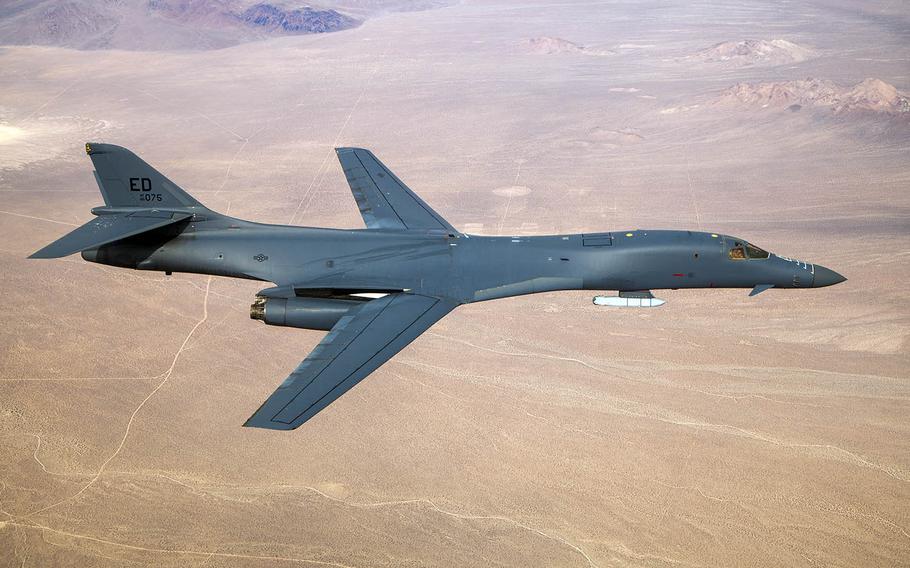
A B-1B Lancer carries an inert external missile during a demonstration over Edwards Air Force Base, Calif., Nov. 20, 2020. (Ethan Wagner/U.S. Air Force)
A B-1B bomber flew with an externally mounted missile for the first time during a demonstration Friday over Edwards Air Force Base, Calif., the Air Force said Tuesday.
The Lancer carried – but did not drop – an inert Joint Air-to-Surface Standoff Missile under an external pylon, the service said in a news release.
The successful demonstration “may pave the way possibly for the B-1B to carry hypersonic weapons externally,” the Air Force said.
Hypersonic weapons travel faster than Mach 5 but have the maneuvering capabilities of cruise missiles during their entire flight.
“Adapting a small number of our healthiest B-1s to carry hypersonic weapons is vital to bridge between the bomber force we have today, to the force of tomorrow,” Gen. Tim Ray, head of the Air Force Global Strike Command, said in the news release.
The Lancer was assigned to the 412th Test Wing’s 419th Flight Test Squadron, Global Power Combined Test Force.
“This is a major step forward in our global precision fires capability and it is important we pursue these technologies to remain ahead of our competitors,” Ray said. “My goal is to have a limited number of B-1s modified to become the roving linebacker of the western Pacific and the North Atlantic.”
The demonstration follows a year of ground tests, which began with the modification of the bomber’s internal bomb bay. The configuration allowed the aircraft to carry larger-sized weapons internally and externally, the Air Force said.
“The B-1B was initially designed to incorporate a moveable bulkhead and usable external hard points for its original nuclear mission, however the U.S. shifted the Lancer’s mission to conventional weapons in 1994,” the Air Force said.
The physical conversion of Lancers to conventional-only armaments was completed between 2007 to 2011, the Air Force said.
“The captive-carry event is actually not a test, but a demonstration to revalidate the previously dormant external carry capability pre-existing on the B-1,” Lt. Col. David Faggard, a spokesman for the Global Strike Command, told Military.com on Tuesday. “No major modifications were needed.”
“The demonstration could mean a potential boon for combatant commanders as the increase in weapons stores remedies an immediate shortfall due to the limited number of strategic bombers,” the news release said. “The proposed increase in capacity means that two bombers would equal to three bombers’ worth of weapons.”
Engineers are now reviewing data gathered from the so-called “captive-carry” demonstration before moving on the next phase – the actual release of an external weapon.
“For us, we’re looking to do this safely, since this is the first time we will release a weapon from the external hard point in over 30 years,” Agustin Martinez, the project test lead, said in the news release.
He said this “safe build up approach” ensures that the missile and bomber are “communicating correctly” and that the projectile “has correct surface deployment timelines so once it does get released it will safely separate.”
Engineers with the Air Force Test Center, B-1 System Program Office and Boeing are all involved in verifying the proper integration of the missile and pylon. They are also analyzing how the configuration affects the bomber’s aerodynamics and software.
“This is a great example of how we are accelerating change to meet our adversaries, and the engineers and operators should be commended for their work in getting this demonstration completed,” Ray said in the news release. “We will continue to invest in and modernize the bomber fleet while increasing the lethality of our global precision fires to be anywhere and anytime.”
The Air Force noted in the news release that the demonstration does not alter the service’s request to retire 17 B-1B bombers in 2021.
olson.wyatt@stripes.com Twitter: @WyattWOlson